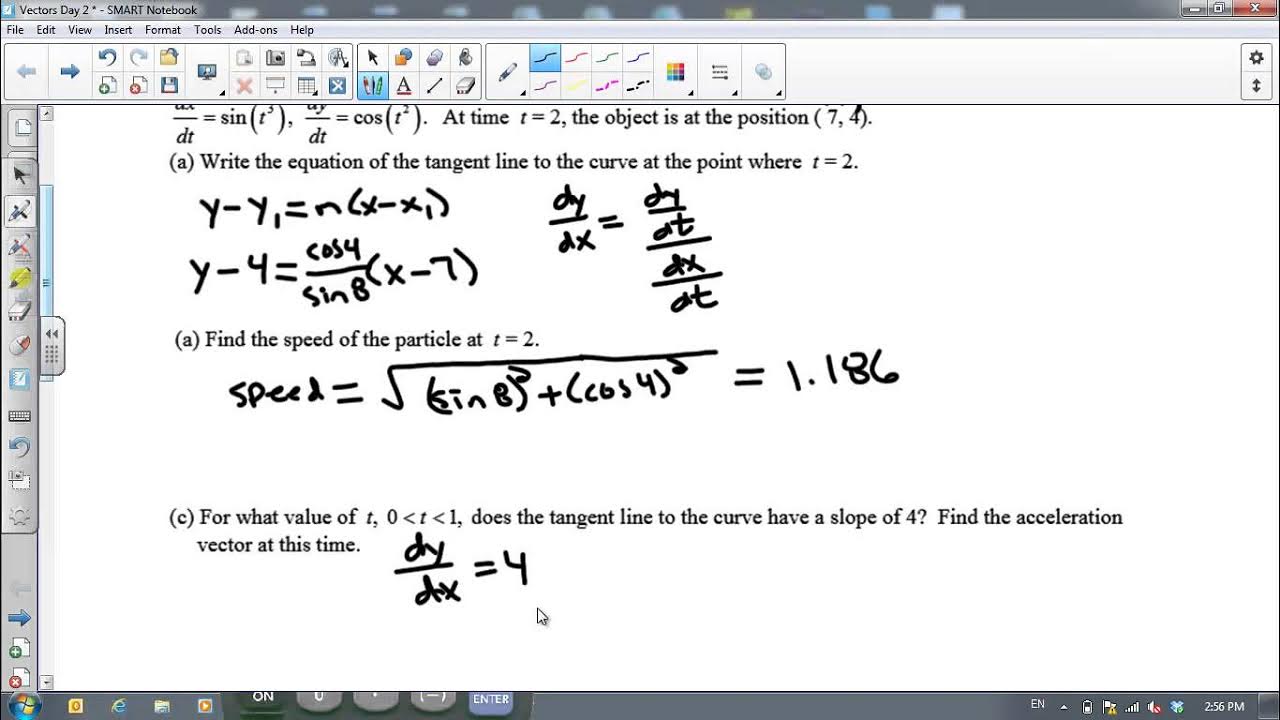2011 Calculus BC free response #1a | AP Calculus BC solved exams | AP Calculus BC | Khan Academy
TLDRThe video script discusses a physics problem involving a particle's motion in the xy-plane. The problem provides the first derivatives of the particle's position functions and initial conditions. The solution involves calculating the velocity and speed of the particle at t=3 using the given derivatives and initial positions. The script also explains how to find the acceleration vector at t=3 by taking the second derivatives of the position functions. The solution process includes applying the Pythagorean theorem to find the speed and using calculus rules to determine the acceleration components. The final results are presented in engineering notation, providing the speed and acceleration vector components at the specified time.
Takeaways
- 📌 The problem involves a particle moving in the xy-plane with given first derivatives of position functions x(t) and y(t).
- 🔄 The velocity vector of the particle is derived from the first derivatives of x(t) and y(t), represented as (4t+1)i + sin(t^2)j.
- ⏱️ At time t=3, the velocity vector is calculated by substituting t with 3, resulting in (13)i + sin(9)j.
- 📏 The speed of the particle at t=3 is found using the Pythagorean theorem, yielding approximately 13.007 units.
- 🚀 The acceleration vector is determined by taking the second derivatives of x(t) and y(t), represented as 4i + 2t*cos(t^2)j.
- 🌟 The acceleration vector at t=3 is calculated by substituting t with 3, resulting in 4i - 5.467j.
- 📈 The script provides a step-by-step method for solving problems involving vectors, derivatives, and the application of the Pythagorean theorem.
- 🔢 The use of a calculator is permitted and encouraged for accurate computation of values in the problem.
- 📚 The problem-solving approach is explained in a clear and detailed manner, suitable for educational purposes.
- 🔑 The key to solving the problem lies in understanding the relationship between position, velocity, and acceleration vectors.
- 🎯 The script emphasizes the importance of precise calculations and the correct application of mathematical concepts.
Q & A
What is the position of the particle at time t=0?
-At time t=0, the particle is at position (x(0), y(0)) which is (0, -4).
What are the expressions for the first derivatives of x and y with respect to time t?
-The first derivative of x with respect to t, denoted as x'(t), is 4t+1. The first derivative of y with respect to t, denoted as y'(t), is sin(t^2).
How is the velocity vector of the particle expressed in terms of its components?
-The velocity vector is expressed as the x-component times the i unit vector plus the y-component times the j unit vector. At any time t, it is given by (4t+1)i + sin(t^2)j.
What is the speed of the particle at time t=3?
-The speed of the particle at time t=3 is approximately 13.007, which is the magnitude of the velocity vector at that time.
How can the magnitude of the velocity vector be calculated?
-The magnitude of the velocity vector is calculated using the Pythagorean theorem, which involves taking the square root of the sum of the squares of the i and j components.
What are the expressions for the acceleration vector components of the particle?
-The acceleration vector components are found by taking the second derivatives of x and y with respect to time. The x-component is 4 (since the first derivative of x is 4t+1 and its derivative is 4), and the y-component is 2t*cos(t^2).
What is the acceleration vector of the particle at time t=3?
-At time t=3, the acceleration vector of the particle is 4i - 5.467j, where the i-component is 4 and the j-component is calculated from 2*3*cos(9) which equals approximately -5.467.
How does the script mention the use of a calculator?
-The script mentions that a calculator can be used during the part of the exam where the magnitude of the velocity vector and the acceleration vector components need to be calculated.
What is the significance of the Pythagorean Theorem in this context?
-The Pythagorean Theorem is used to calculate the magnitude of the velocity vector, which is the speed of the particle, by finding the square root of the sum of the squares of its i and j components.
How does the script describe the notation used for the vectors?
-The script describes the use of engineering notation for the vectors, which is a method of representing vectors using their components along the i and j unit vectors. It also mentions that vectors could be represented in parametric or ordered-pair notation.
What is the relationship between the first and second derivatives of the particle's position?
-The first derivatives of the particle's position with respect to time represent the velocity vector, while the second derivatives represent the acceleration vector. The second derivative is essentially the derivative of the first derivative.
Outlines
📐 Velocity and Speed Calculation
This paragraph discusses the problem of finding the speed of a particle in the xy-plane at a specific time and the acceleration vector. The particle's position is given by functions x(t) and y(t), with their derivatives provided as x'(t) = 4t + 1 and y'(t) = sin(t^2). The initial conditions are x(0) = 0 and y(0) = -4. The velocity vector is derived from these functions and is expressed in engineering notation. The speed at time t=3 is calculated by finding the magnitude of the velocity vector using the Pythagorean theorem, resulting in approximately 13.007. The acceleration vector is then determined by taking the second derivative of the position functions, with the x-component being the derivative of the first derivative of x(t), yielding 4, and the y-component being the derivative of the first derivative of y(t), resulting in 2t*cos(t^2). At t=3, the acceleration vector components are 4i and -5.467j.
🚀 Acceleration Vector at t=3
The focus of this paragraph is to calculate the acceleration vector of the particle at time t=3. The acceleration vector is obtained by taking the second derivative of the position functions with respect to time. The x-component of the acceleration vector is simply the derivative of the first derivative of x(t), which is 4. The y-component involves the derivative of the first derivative of y(t), calculated using the chain rule, resulting in 2t*cos(t^2). At t=3, the acceleration vector is found by substituting t with 3, yielding 4i and -5.467j. The paragraph emphasizes the use of a calculator to obtain precise values and mentions different notations for representing vectors, such as engineering, parameterized, and ordered-pair notations.
Mindmap
Keywords
💡particle
💡velocity vector
💡speed
💡acceleration vector
💡derivative
💡magnitude
💡unit vector
💡engineering notation
💡Pythagorean Theorem
💡chain rule
💡parametrized vector notation
Highlights
The problem involves a particle moving in the xy-plane, with its position given by functions x(t) and y(t).
The derivative of x with respect to t is given by 4t+1, and the derivative of y with respect to t is sin(t^2).
At time t=0, the initial conditions are x(0)=0 and y(0)=-4.
The speed of the particle is the magnitude of the velocity vector.
The velocity vector is represented as the derivative of x(t) times the i unit vector plus the derivative of y(t) times the j unit vector.
At time t=3, the velocity vector is calculated as 13i + sin(9)j.
The magnitude of the velocity vector at t=3 is found using the Pythagorean Theorem, resulting in approximately 13.007.
The acceleration vector is the second derivative of the position functions with respect to time.
The second derivative of x(t) is a constant 4, representing the acceleration in the x-direction.
The second derivative of y(t) is found using the chain rule, resulting in 2t*cos(t^2) for the acceleration in the y-direction.
At time t=3, the acceleration vector is calculated as 4i - 5.467j.
Engineering notation is used to express the velocity and acceleration vectors.
The problem demonstrates the application of calculus in physics to determine the motion of a particle.
The solution process involves a step-by-step approach to finding derivatives and utilizing them to calculate speed and acceleration.
The use of a calculator is allowed to find the numerical values of trigonometric functions at specific points in time.
The problem showcases the relationship between a particle's position, velocity, and acceleration in a two-dimensional plane.
The magnitude of the velocity vector is an important aspect in understanding the kinetic energy of a moving particle.
The problem highlights the practical use of mathematical concepts in describing the motion of objects in a physical context.
Transcripts
5.0 / 5 (0 votes)
Thanks for rating:





